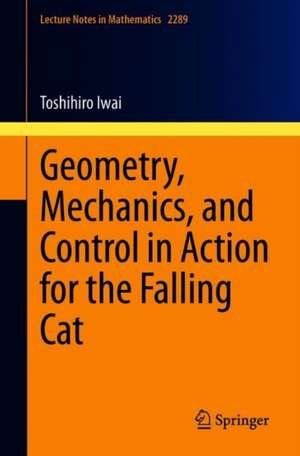Geometry, Mechanics, and Control in Action for the Falling Cat: Lecture Notes in Mathematics, cartea 2289
Autor Toshihiro Iwaien Limba Engleză Paperback – 24 apr 2021
Din seria Lecture Notes in Mathematics
- 17%
 Preț: 360.43 lei
Preț: 360.43 lei -
 Preț: 459.92 lei
Preț: 459.92 lei -
 Preț: 121.41 lei
Preț: 121.41 lei -
 Preț: 175.68 lei
Preț: 175.68 lei -
 Preț: 197.00 lei
Preț: 197.00 lei -
 Preț: 279.76 lei
Preț: 279.76 lei -
 Preț: 477.66 lei
Preț: 477.66 lei - 17%
 Preț: 361.89 lei
Preț: 361.89 lei -
 Preț: 252.37 lei
Preț: 252.37 lei -
 Preț: 353.99 lei
Preț: 353.99 lei -
 Preț: 138.88 lei
Preț: 138.88 lei -
 Preț: 152.61 lei
Preț: 152.61 lei -
 Preț: 116.67 lei
Preț: 116.67 lei -
 Preț: 102.77 lei
Preț: 102.77 lei - 17%
 Preț: 365.53 lei
Preț: 365.53 lei -
 Preț: 396.76 lei
Preț: 396.76 lei - 17%
 Preț: 362.15 lei
Preț: 362.15 lei -
 Preț: 396.13 lei
Preț: 396.13 lei -
 Preț: 357.80 lei
Preț: 357.80 lei - 17%
 Preț: 362.31 lei
Preț: 362.31 lei -
 Preț: 403.81 lei
Preț: 403.81 lei - 17%
 Preț: 361.73 lei
Preț: 361.73 lei -
 Preț: 499.87 lei
Preț: 499.87 lei -
 Preț: 457.03 lei
Preț: 457.03 lei -
 Preț: 395.91 lei
Preț: 395.91 lei -
 Preț: 459.00 lei
Preț: 459.00 lei -
 Preț: 487.57 lei
Preț: 487.57 lei -
 Preț: 424.01 lei
Preț: 424.01 lei -
 Preț: 487.57 lei
Preț: 487.57 lei -
 Preț: 330.55 lei
Preț: 330.55 lei -
 Preț: 325.75 lei
Preț: 325.75 lei -
 Preț: 350.30 lei
Preț: 350.30 lei -
 Preț: 331.31 lei
Preț: 331.31 lei -
 Preț: 408.37 lei
Preț: 408.37 lei -
 Preț: 328.25 lei
Preț: 328.25 lei -
 Preț: 421.28 lei
Preț: 421.28 lei -
 Preț: 276.08 lei
Preț: 276.08 lei -
 Preț: 424.60 lei
Preț: 424.60 lei -
 Preț: 422.05 lei
Preț: 422.05 lei -
 Preț: 505.01 lei
Preț: 505.01 lei -
 Preț: 422.05 lei
Preț: 422.05 lei -
 Preț: 274.93 lei
Preț: 274.93 lei -
 Preț: 335.16 lei
Preț: 335.16 lei -
 Preț: 422.27 lei
Preț: 422.27 lei -
 Preț: 497.49 lei
Preț: 497.49 lei -
 Preț: 272.81 lei
Preț: 272.81 lei -
 Preț: 428.04 lei
Preț: 428.04 lei -
 Preț: 376.22 lei
Preț: 376.22 lei -
 Preț: 427.10 lei
Preț: 427.10 lei -
 Preț: 325.92 lei
Preț: 325.92 lei
Preț: 456.10 lei
Nou
Puncte Express: 684
Preț estimativ în valută:
87.27€ • 95.10$ • 73.54£
87.27€ • 95.10$ • 73.54£
Carte tipărită la comandă
Livrare economică 23 aprilie-07 mai
Preluare comenzi: 021 569.72.76
Specificații
ISBN-13: 9789811606878
ISBN-10: 9811606870
Pagini: 182
Ilustrații: X, 182 p. 24 illus., 5 illus. in color.
Dimensiuni: 155 x 235 x 15 mm
Greutate: 0.45 kg
Ediția:1st ed. 2021
Editura: Springer Nature Singapore
Colecția Springer
Seria Lecture Notes in Mathematics
Locul publicării:Singapore, Singapore
ISBN-10: 9811606870
Pagini: 182
Ilustrații: X, 182 p. 24 illus., 5 illus. in color.
Dimensiuni: 155 x 235 x 15 mm
Greutate: 0.45 kg
Ediția:1st ed. 2021
Editura: Springer Nature Singapore
Colecția Springer
Seria Lecture Notes in Mathematics
Locul publicării:Singapore, Singapore
Cuprins
1 Geometry of many-body systems.- 2 Mechanics of many-body systems.- 3 Mechanical control systems.- 4 The falling cat.- 5 Appendices.
Recenzii
“This is a unique book, probably first of its kind … . The concepts of rotation and vibration is thoroughly examined and explained. … The appendices contain advanced material concerning many-body systems and related topics together with Newton’s law of gravitation. This is an interesting book!” (Girish Kumar Ramaiah, zbMATH 1472.70001, 2021)
Textul de pe ultima copertă
The falling cat is an interesting theme to pursue, in which geometry, mechanics, and control are in action together. As is well known, cats can almost always land on their feet when tossed into the air in an upside-down attitude. If cats are not given a non-vanishing angular momentum at an initial instant, they cannot rotate during their motion, and the motion they can make in the air is vibration only. However, cats accomplish a half turn without rotation when landing on their feet. In order to solve this apparent mystery, one needs to thoroughly understand rotations and vibrations. The connection theory in differential geometry can provide rigorous definitions of rotation and vibration for many-body systems. Deformable bodies of cats are not easy to treat mechanically. A feasible way to approach the question of the falling cat is to start with many-body systems and then proceed to rigid bodies and, further, to jointed rigid bodies, which can approximate the body of a cat.In this book, the connection theory is applied first to a many-body system to show that vibrational motions of the many-body system can result in rotations without performing rotational motions and then to the cat model consisting of jointed rigid bodies. On the basis of this geometric setting, mechanics of many-body systems and of jointed rigid bodies must be set up. In order to take into account the fact that cats can deform their bodies, three torque inputs which may give a twist to the cat model are applied as control inputs under the condition of the vanishing angular momentum. Then, a control is designed according to the port-controlled Hamiltonian method for the model cat to perform a half turn and to halt the motion upon landing. The book also gives a brief review of control systems through simple examples to explain the role of control inputs.
Caracteristici
Gives undergraduate and graduate students alike a vivid idea of connection theory in action for many-body systems Shows that geometric mechanics for many-body systems works well in dealing with the falling cat problem Adapts geometric mechanics for the falling cat problem in the formulation of the port-controlled Hamiltonian system
